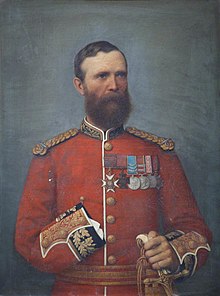General Sir Mark Walker VC, KCB (24 November 1827 – 18 July 1902) was a British Army officer and an Irish recipient of the Victoria Cross, the highest award for gallantry in the face of the enemy that can be awarded to British and Commonwealth forces.
Sir Mark Walker | |
|---|---|
 Walker in around 1891, by an unknown artist | |
| Born | 27 November 1827 Finea, County Westmeath, Ireland |
| Died | 18 July 1902 (aged 74) Arlington Rectory, Devon, England |
| Buried | Cheriton Road Cemetery, Folkestone |
| Allegiance | United Kingdom |
| Service | British Army |
| Years of service | 1846–1893 |
| Rank | General |
| Unit | 30th Regiment of Foot 3rd Regiment of Foot |
| Battles / wars | Crimean War Second Opium War |
| Awards | Victoria Cross Knight Commander of the Order of the Bath Order of the Medjidie, 5th Class (Ottoman Empire) |
| Relations | Sir Samuel Walker, 1st Baronet |
| Other work | Honorary Colonel of the Sherwood Foresters |
Early life
editWalker was born in Gore Port, Finea, County Westmeath in Ireland, the son of Captain Alexander Walker and Elizabeth Elliott. His younger brother was Sir Samuel Walker, 1st Baronet QC, Liberal MP for Londonderry, Solicitor-General for Ireland, Attorney-General for Ireland and Lord Chancellor of Ireland.
Victoria Cross
editDuring the Crimean War, Walker was a 26-year-old lieutenant in the 30th Regiment of Foot (later the East Lancashire Regiment) British Army when the deed for which he was awarded the VC was performed.
On 5 November 1854 at Inkerman, Crimea, Lieutenant Walker jumped over a wall in the face of two battalions of Russian Infantry which were marching towards it. This act was to encourage the men, by example, to advance against such odds – which they did and succeeded in driving back both battalions.[1][2]
His Victoria Cross was until recently on display at The Buffs Regimental Museum, Canterbury, England. With the rest of that museum's collections, it has now been transferred to the National Army Museum, where it is not currently on display.
Later life
editHe was wounded by a howitzer shell during his service in the Crimea which resulted in the amputation of his right arm. He served through the Second Anglo-Chinese War of 1860 as brigade major, and in 1861 he received the rank of lieutenant-colonel. Promotion to colonel followed in 1869, and from 1875 to 1879 he commanded a brigade in Madras, during which he was promoted to major-general in 1878. From 1883 to 1884 he was at Aldershot, then in command of a brigade at Gibraltar until 1888, when he was promoted lieutenant-general. He retired from the army with the rank of general in 1893, and was appointed a Knight Commander of the Order of the Bath.[3]
From 1900 until his death he was colonel of the Sherwood Foresters.
He died at Arlington, Devon, England on 18 July 1902.[3]
A memorial wall plaque honouring Sir Mark is found at Canterbury Cathedral.
Personal life
editIn 1881 Walker married Catherine Chichester.
References
edit- ^ "No. 22149". The London Gazette. 4 June 1857. p. 2756.
- ^ National Army Museum Archived 20 August 2010 at the Wayback Machine
- ^ a b "Obituary - General Sir Mark Walker, VC". The Times. No. 36825. London. 21 July 1902. p. 6.
- List of Irish Victoria Cross recipients
- The Register of the Victoria Cross
- Clarke, Brian D. H. (1986). "A register of awards to Irish-born officers and men". The Irish Sword. XVI (64): 185–287.
- Ireland's VCs ISBN 1-899243-00-3 (Dept of Economic Development, 1995)
- Monuments to Courage (David Harvey, 1999)
- Irish Winners of the Victoria Cross (Richard Doherty & David Truesdale, 2000)